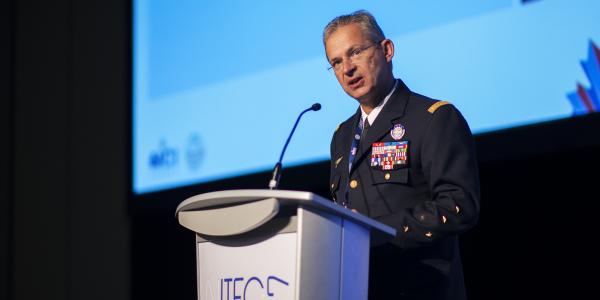Innovation, Security Dominate NATO Challenges
The road for NATO to achieve communications interoperability must be paved with innovation and effective cybersecurity, top leaders recently said. Only then can the alliance fulfill its missions and continue to function as it faces a wide range of threats in a time of tight budgets.
However, identifying technology needs and incorporating them is easier said than done. NATO and its 28 member nations still lack a concrete plan to rush new capabilities into alliance and national systems. Intricate procurement processes compound the absence of cooperation among contracted firms, while cyber adversaries continue to improve and broaden their methods.
These were among the many issues discussed at NITEC 2017 April 24-26 in Ottawa, Ontario. Co-sponsored by AFCEA International and the NATO Communications and Information (NCI) Agency, the conference outlined challenges facing the agency while offering industry a glimpse of opportunities that could benefit both NATO and the private sector.
Ernest J. Herold, NATO’s deputy assistant secretary general for defense investment, spread the cards face up on the table when he said: “For NATO to remain relevant, it needs to adapt to the changing security environment and its challenges.” The alliance needs to be a more informed customer, and industry must be given a sense of NATO’s strategic direction, he continued. Full-spectrum capabilities are still important, even as the organization confronts new challenges. NATO must develop needed capabilities quickly. “We’re developing the means for even more allies to cooperate [in procurement],” Herold reported. “NATO shouldn’t be a port of call for allies. It should be the home port.”
NATO’s Supreme Allied Commander Transformation, Gen. Denis Mercier, FRAF, said interoperability is the alliance’s principal issue. Always a concern, it has risen to critical importance as military capacities have become focused on networks and information technologies. Countries and industry must work together to ensure effective interoperability among advanced technologies, he said.
Inertia received considerable blame for the problems facing NATO technology acquisition. John Stewart, Cisco’s senior vice president and chief security and trust officer, stated, “By the time [an item] is operationally deployed in NATO, my company is ready to retire it.” Systems often are deployed even though their developers know that inherent vulnerabilities could prove costly to forces, he continued. “That is unacceptable,” Stewart added. “I don’t want the day when loss of life is the reason things change.”
Hugh Thompson, chief technology officer for Symantec, said innovation will require investing in and partnering with nontraditional industries such as anthropology and psychology. Paul MacGregor, senior vice president, security and smart systems, Leonardo, enlarged this point by adding: “Innovation is not just about technology, it’s about process.” He cautioned that giving people an environment where they can innovate, with failures and rewards, is an expensive process. Acknowledging the ongoing technology war in cyberspace, he told attendees to strive for innovation wherever possible. “Don’t reinvent the wheel; harness the power of Silicon Valley and other innovation centers around the world.”
Cybersecurity was a major discussion point. “We are behind in cyberspace, and we have to begin catching up rapidly,” said Dmitri Alperovitch, CrowdStrike’s co-founder and chief technology officer. Maj. Gen. Greg Loos, CF, chief of staff, Information Management Group/CAF J-6 for Canada’s Department of National Defence, expanded that point: “Information is the lifeblood and currency of military operations, and we must share it. Cyber challenges are the same for all of our nations. We must work together.”
Gen. Mercier noted that the complexity of today’s environment will make surprise inevitable and permanent. The alliance must focus more on cyber than on its military platforms. Ensuring that cyber is part of a system at the beginning of its development will require “[the] need to get outside our walls,” he said.
Mark Anderson, president of Palo Alto Networks, said new approaches to security and network architecture must be implemented to turn the tide against cyber adversaries. “The past decade, there have been tectonic shifts in the [information technology] landscape that created the perfect storm,” Anderson said. He mentioned several activities—and the lack of others—that enabled adversaries to take advantage of their own burgeoning skills to penetrate networks nearly at will.





Comments